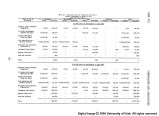| OCR Text |
Show PART VI FRAMEWORK PLAN AND ALTERNATIVES Municipal and Industrial Water Future municipal and industrial "water supply requirements "will "be met by developing additional surface and ground water sources. In a few isolated cases, needs will be met by conversions of irrigation use to mu- nicipal and industrial uses. The amount of water these conversions rep- resent is small, however. Use of surface sources will be by far the most common means and account for the largest segment of meeting the future needs. This is borne out by the fact that authorized projects are under- way or will be constructed in all major areas of expanding needs. Where populations are lightly concentrated, multipurpose projects have been planned and, in many cases, are authorized with adequate allocations for municipal and industrial requirements developed from projections. It is estimated that 70 to 80 percent of the future water supply in each time frame would be met by non-Federal development. Because of the rural character of the region, many small community systems will be developed by non-Federal funds. Self-supplied systems delivering ground water will continue to make up a small portion of the future industrial supplies. The program includes installation of water development, conveyance, and treatment facilities. Recreation - fish and wildlife Recreation Recreation land and water facilities will be made available for res- ident and nonresident use, totaling an increase of about 170 million recreation-days by 2020. About 1+35,000 acres of additional land will be developed for recreation needs. Undeveloped lands will be managed for op- timum recreation use as well as other compatible uses. Increased use of multiple-use land for recreation is desirable. In addition, many large areas would provide more recreational opportunities if better access were provided. It is important that land use studies be completed to determine tine best uses of all lands in the region. As a part of this type analysis, optimum carrying capacities of recreation lands would be established and the areas administered accordingly to prevent deterioration of the re- source base and to insure quality experience to the recreationists. Since most of the demand for recreation opportunities is generated by nonresi- dents of the region and the quality of the region's recreation resources is still relatively high, special care would be taken to insure well- planned development of facilities and measures would be initiated to pre- vent overdevelopment, overuse, or misuse. Special efforts will be made to increase opportunities for recrea- - tional use of water in streams and reservoirs. This will require road, construction, right-of-way acquisition, and revised legislation. 69 |













































































































































